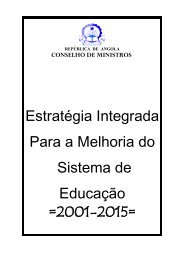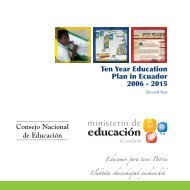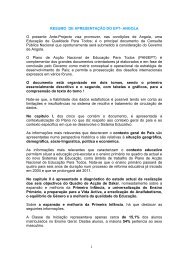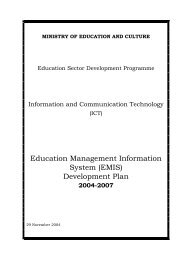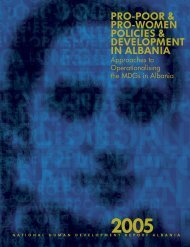Education Sector Strategic Plan 2004-2015 - Planipolis
Education Sector Strategic Plan 2004-2015 - Planipolis
Education Sector Strategic Plan 2004-2015 - Planipolis
You also want an ePaper? Increase the reach of your titles
YUMPU automatically turns print PDFs into web optimized ePapers that Google loves.
Final ESSP<br />
In 2002 the Ministry’s <strong>Education</strong> <strong>Plan</strong>ning Department contracted a consultant team<br />
to review progress in implementing the ESIP, recommend detailed revisions to its<br />
objectives and targets, and outline a strategy for the sector up to <strong>2015</strong>. The<br />
consultants’ findings were discussed and accepted at a workshop in January 2003,<br />
and they constitute an important element of the foundation for this second <strong>Plan</strong>.<br />
1.11 Department strategic plans<br />
Subsequent to the Mid-Term Review, the Department of <strong>Plan</strong>ning asked each<br />
department within the Ministry to develop a logical framework based on the one<br />
agreed-upon at the review workshop. The drafts of these plans have been<br />
incorporated into the process of developing this <strong>Plan</strong>, and they are used as the basis<br />
of department work plans that follow from the <strong>Plan</strong>.<br />
1.12 Poverty Eradication Action <strong>Plan</strong><br />
The Ministry of <strong>Education</strong> and Sports’ section of the government’s Poverty<br />
Eradication Action <strong>Plan</strong> (PEAP) for the years <strong>2004</strong>-05 to 2006-07 has been<br />
developed in synchronization with this <strong>Plan</strong>. Two of the four pillars of the PEAP are<br />
“increased ability of the poor to raise their incomes,” and “enhanced quality of life<br />
of the poor.” The education section of the PEAP is geared toward those aspects of<br />
the education sector that most directly address poverty issues. It is also a<br />
comprehensive presentation of the sector, as its systemic nature makes it difficult to<br />
ignore any aspect of its objectives and strategies.<br />
1.13 Process of developing the ESSP<br />
To develop the ESSP, EPD and its consultant team began with the logical<br />
frameworks submitted by each department following the Mid-Term Review of the<br />
ESIP. These frameworks became the basis of a logical framework in the PEAP and<br />
of the policy objectives and strategies of the ESSP. The Ministry’s Monitoring and<br />
Evaluation Working Group, the <strong>Sector</strong> Policy and Management (SPM) Working<br />
Group, the <strong>Education</strong> <strong>Sector</strong> Consultative Committee (ESSC), and Ministry Top<br />
Management reviewed a draft ESSP. Based on discussions in each of these<br />
meetings, the draft ESSP was revised. Once the draft was fairly well elaborated, a<br />
National Consultative Workshop was held; participants included district education<br />
cadres as well as representatives from the Ministry and members of the <strong>Education</strong><br />
Funding Agencies Group (EFAG). The final review of the draft took place in the<br />
Ministry’s first <strong>Education</strong> <strong>Sector</strong> <strong>Plan</strong>ning and Budget Workshop - the first such<br />
annual workshop, which replaces the spring <strong>Education</strong> <strong>Sector</strong> Review.<br />
The result of this workshop was an agreement on the broad lines of the ESSP as well<br />
as on the objectives and strategies of each sub-sector. The workshop also gave some<br />
guidance on how to reduce costs to fit the ESSP within the Long-Term Expenditure<br />
Framework (LTEF). After the workshop, the <strong>Education</strong> <strong>Plan</strong>ning Department (EPD)<br />
made such adjustments to the expenditure framework and translated it into the<br />
Medium-Term Budget Framework through 2006-07.<br />
4



